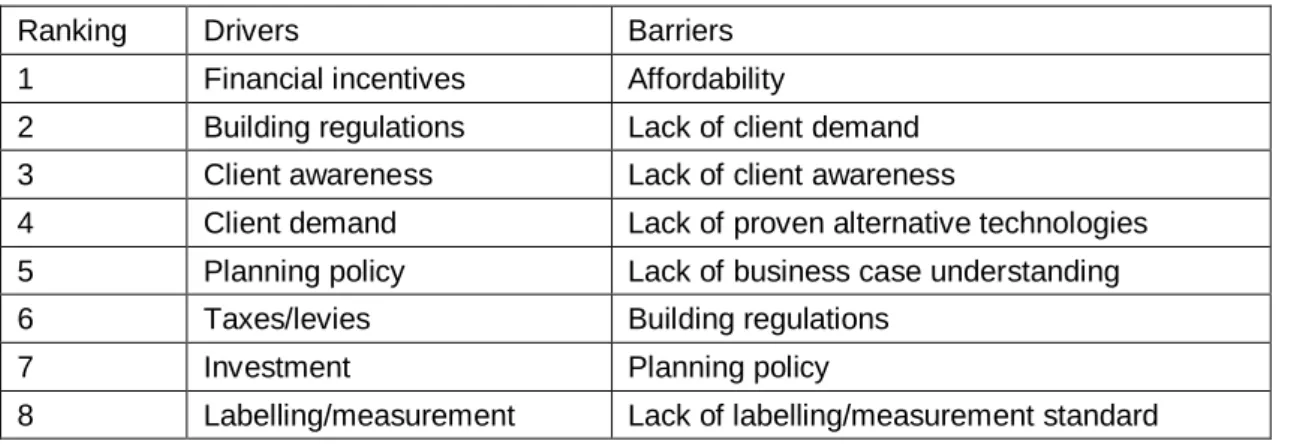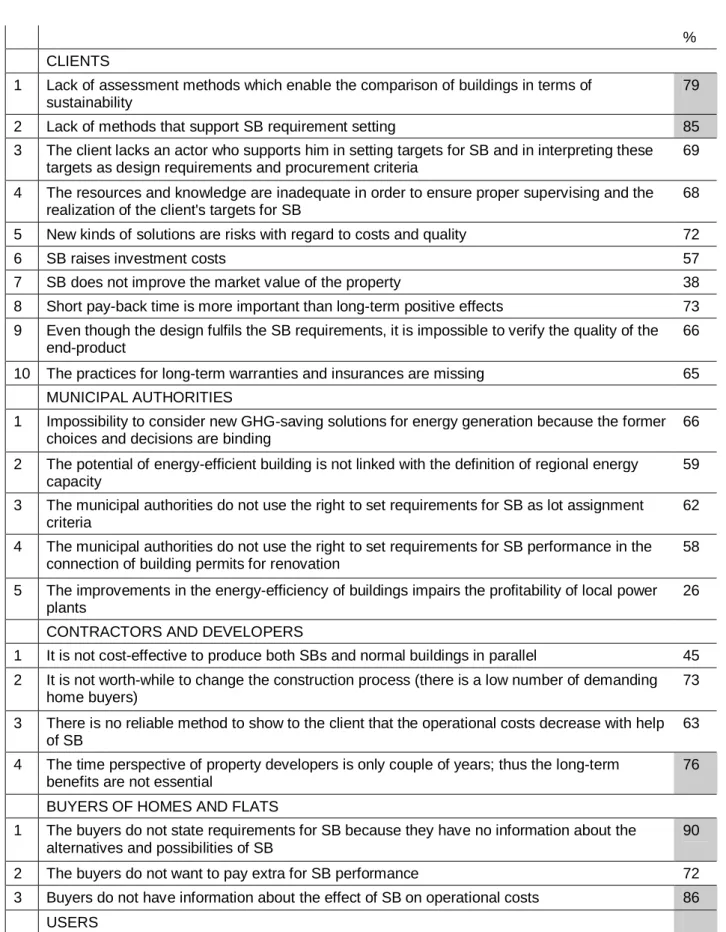The premise of the work was that SB is not hindered because of a lack of information, technology and assessment methods, but because it is difficult to adopt new methods. Based on the results, the paper discusses what actions are needed to promote SB. The barriers and drivers for SB were analyzed with the help of literature study and with the help of interviews.
Based on the results, fiscal incentives and regulations help promote SB. In order for clients to be willing to invest in SB, they should be able to rely on the positive effect of SB on the market value and/or utility value of the building.
Procurement and tendering processes
Important to the success of SB is how the client selects the design and procurement team and how they formulate building performance metrics. The design team must understand the client's budget, program, functional requirement and corporate responsibility values.” address that procurement processes are fundamental to improving building performance and therefore also SB. The choice of the most suitable procurement route and form of contract will require better analysis explicitly to relate to characteristics of the project such as the client's ambitions and risks. 2005) also addresses that in a successful project, all performance requirements must refer to a separate library of assessment methods.
Process phases and scheduling of tasks
Choosing the most appropriate procurement route and form of contract will require better analysis to relate explicitly to such characteristics of the project as the client's ambitions and risks. 2005) also addresses that in a successful project, all performance requirements must refer to a separate library of assessment methods that have analyzed the necessary characteristics for SB projects; they address the indications in Table 2. Accurate estimation of costs in early stages of SB projects supports projects to select high performance and SB features based on the owner's budget. 2005) emphasizes the role of the project manager who represents the client. Active involvement in demand specification by end user is one of the drivers of process innovation and supply; thus, managing end-user participation is extremely important.
Cooperation and networking
have analyzed the required functions for SB projects; they address the indications shown in Table 2. They suggest that it is important for SB that construction organizations are part of the team during the design. An evaluation process for technical solutions must be organized, verification methods and auditor's roles must be established.
Additional requirements are needed in the delivery processes for SBs to achieve their performance benefits (Horman et al. 2005). SB projects require intensive interdisciplinary collaboration, highly complex design analysis and careful material and system selection, especially early in the project delivery process. The public sector could play a notable role in initiating the supply chain transformation towards better collaboration and shared goals (Anon 2007).
One of the real challenges of sustainable development is that it requires innovation, new knowledge and learning within public and private sector organizations (Rydin 2008). To implement green ideas at all levels of an organization, key environmental actors must be given decision-making mandates. -Minh and Naim (2001) say that strong segmentation of an organization's departments hinders companies' ability to fully focus on the end customer because there is no holistic view of the supply chain.
Companies should exchange information on good practices in order to learn from each other's experiences. 2005) point out that knowledge management and sharing are essential drivers of all innovation in large construction organizations.
Knowledge and common language
SB is hampered not only by problems in communication and interaction between individual actors and firms, but also by management and communication-related issues within organizations. A concrete suggestion would be the acceptance of key environmental actors in business management (Stenberg 2006). Although many of the actors involved in the construction sector claim to strive for sustainability, the uniformity of language does not mean that there is uniformity in the practice associated with this discourse (Rohracher 2001).
Stenberg (2006) also investigated what is the main source of environmental information for decision makers in the Swedish construction sector. Williams and Dair (2007) address the lack of knowledge as the main problem related to several different barriers. 2006) argue that although designers demonstrate confidence in their ability to access and use knowledge in general, this confidence declines when the specific issue of SB is addressed. They emphasize that it is very important to be able to communicate sustainability in a project's map.
The study suggests that appropriate management skills for sustainability planning are critical in overcoming barriers and continuing to implement SB models. The skills required to manage/lead SB design were summarized as follows: awareness, communication, understanding, experience, lateral thinking, leadership, negotiation, passion and technical knowledge. SB knowledge should also be available as specialized service packages, as many companies are too small to remain competent in the full range of issues involved (Rohracher presents the lack of information as a major problem in energy efficient construction, especially in the residential sector).
Sodagar and Fieldson (2008) point out that in order to design a true SB, the design team must have access to the best available information about products and materials and tools by means of which this data can be transferred and used in calculations.
Availability of integrated methods
Companies that sell houses should be obliged to inform the customer about efficient solutions for the life cycle, instead of selling the cheapest alternative without considering the higher running costs. Building performance assessment practices also lack continuity throughout the building life cycle (Sullivan et al. 2004). Furthermore, designers need life cycle assessment tools, energy consumption estimation methods and lifetime prediction methods that support them to compare alternative solutions.
They present an LCADesign tool that integrates a wide range of modules from a database including IFC definitions and product life cycle data. Currently, the evaluation process is usually performed when the project design is almost finalized. Sustainability should be pursued with the help of an integrated approach which is able to recognize aspects of sustainability in all selections (Sodagar and Fieldson 2008).
Sophisticated computer-based planning tools are not sufficient for this type of process, but they must be accompanied by fairly simple evaluation procedures that can be used at different stages of the project. The approach based on the building concept enables 1) product development of the final product, 2) repetition of basic building elements from one project to another and 3) customization of the final product taking into account the specific needs of the case and the client. Information management enables 1) consideration of the broad spectrum of aspects including building performance, environmental aspects, life cycle costs and service life, and 2) rapid adaptation of the design to case-specific requirements.
Decision support tools are needed to support the understanding of value, risks, performance and condition, remaining life, required maintenance and optimal life cycle operation planning of buildings and other construction assets (Vanier 2001), (Lorenz and Lützkendorf 2007). .
Innovation
Results of the web-based inquiry
The most important barriers noted by respondents in the web-based questionnaire are shown in Table 5. Respondents addressed lack of customer awareness, competence of designers and other stakeholders, availability of tools, lack of economic incentives, lack of of sustainability, renovation concepts and new related services for maintenance and energy supply. Consequently, the most relevant SB measures would include developing and disseminating SB information to professional clients as well as home buyers, developing and using tools for measuring, monitoring and benchmarking SB solutions, supporting designers to enabling the improvement of competences, the development and use of economic incentives in order to increase the attractiveness of SB investments, and the development of the concepts of sustainable renewal, maintenance services and energy services.
Results of the personal interviews Regulations, innovations, tools
The majority of interviewees said that new methodologies, labeling systems and other supporting tools for SB are needed to promote SB. Based on the results, unjustified fear of costs is not considered an important barrier. A majority of actors appear to have a realistic understanding of the true costs of SB.
New solutions should be thoroughly researched and the suppliers should provide good quality information designers and builders to convince the players about the reliability of the new solutions. One possibility could also be to make use of the labeling systems to improve the availability of information on acceptable SB solutions. Based on the results, the following conclusions were drawn about the most important measures to enable and strengthen SB processes.
In order to enable the sharing and transfer of the desired information between information services and software tools, it is necessary to agree on the standards to be applied (IFC, IFD). Based on the results, conclusions were drawn about the actions needed to promote SB. The Finnish interviewees particularly emphasized the importance of demand, role of customers and especially public customers, the role and cooperation of the designers and the lack of methods and tools.
Based on the results, the following conclusions were made about the most important measures to promote SB processes: 1) development of awareness of home buyers about the potential of SB, 2) development and adoption of methods for requesting SB. management, 3) development and mobilization of SB tools, 4) development of competences of designers and teamwork and 5) development of new concepts and services. Accelerating the development of the sustainable construction market in Europe - Report of the Working Group on Sustainable Construction. 1 The main contractor is not able to ensure that the operation and use of the SB is properly managed to ensure the intended operation.


